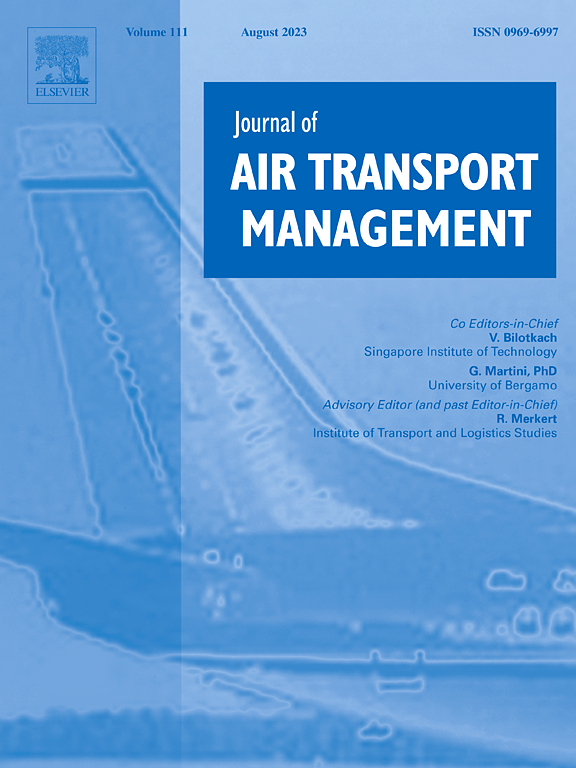Tail assignment problem with hour-to-cycle ratio constraints
IF 3.6
2区 工程技术
Q2 TRANSPORTATION
引用次数: 0
Abstract
Effective management of hour-to-cycle performance is crucial for any aircraft operating under an operating lease contract. This protects an airline from incurring supplemental rental payments that arise from leasing contract terms. One way of managing accumulated flight hours and flight cycles on aircraft is integrating related performance measures in the tail assignment decisions. This study introduces the tail assignment problem (TAP) considering aircraft’s hour-to-cycle ratio performance. We introduce a novel TAP formulation explicitly incorporating aircraft hour-to-cycle ratio constraints, which are typically overlooked in traditional models. Our numerical analysis demonstrates that overlooking the hour-to-cycle performance of aircraft in tail assignment decisions can result in drastic deviations from target ratios. Therefore, we propose a mathematical model that includes penalty costs for violating the aircraft’s target hour-to-cycle ratios. We propose one McCormick linearization and one second-order conic reformulation for the nonlinear constraints in the model. We perform computational analyses by generating problem instances derived from an actual flight schedule. Computational results show that within a given time limit the model with McCormick linearization solves more instances to optimum than the model with conic reformulation. Also, it achieves an average optimality gap of 1.62% while the average gap is 6.39% for the solutions obtained with the conic formulation.
具有小时周期比约束的机尾分配问题
有效的小时周期性能管理对于任何在运营租赁合同下运行的飞机来说都是至关重要的。这可以保护航空公司免于因租赁合同条款而产生的额外租金。在机尾分配决策中整合相关性能指标是管理飞机累计飞行时数和飞行周期的一种方法。研究了考虑飞机小时循环比性能的机尾分配问题。我们引入了一种新的TAP公式,明确地纳入了传统模型中通常被忽视的飞机小时循环比约束。我们的数值分析表明,在尾翼分配决策中忽略飞机的小时循环性能可能导致与目标比率的严重偏差。因此,我们提出了一个数学模型,其中包括违反飞机目标小时周期比的惩罚成本。对于模型中的非线性约束,我们提出了一个麦考密克线性化和一个二阶二次方程。我们通过生成来自实际航班时刻表的问题实例来执行计算分析。计算结果表明,在给定的时间范围内,采用McCormick线性化的模型比采用二次重构的模型能解决更多的最优问题。平均最优性差距为1.62%,而用二次方程求解的平均最优性差距为6.39%。
本文章由计算机程序翻译,如有差异,请以英文原文为准。
求助全文
约1分钟内获得全文
求助全文
来源期刊

Journal of Air Transport Management
TRANSPORTATION-
CiteScore
12.40
自引率
11.70%
发文量
97
期刊介绍:
The Journal of Air Transport Management (JATM) sets out to address, through high quality research articles and authoritative commentary, the major economic, management and policy issues facing the air transport industry today. It offers practitioners and academics an international and dynamic forum for analysis and discussion of these issues, linking research and practice and stimulating interaction between the two. The refereed papers in the journal cover all the major sectors of the industry (airlines, airports, air traffic management) as well as related areas such as tourism management and logistics. Papers are blind reviewed, normally by two referees, chosen for their specialist knowledge. The journal provides independent, original and rigorous analysis in the areas of: • Policy, regulation and law • Strategy • Operations • Marketing • Economics and finance • Sustainability
 求助内容:
求助内容: 应助结果提醒方式:
应助结果提醒方式:


